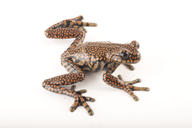|
Hyloscirtus princecharlesi Coloma, Carvajal-Endara, Dueñas, Paredes-Recalde, Morales-Mite, Almeida-Reinoso et al., 2012
Prince Charles Stream Tree Frog | family: Hylidae subfamily: Hylinae genus: Hyloscirtus |
| Species Description: Coloma LA, Carvajal-Endara S, Duenas JF, Paredes-Recalde A, Morales-Mite M, Almeida-Reinoso D, Tapia EE, Hutter CR, Toral E, Guaysamin JM 2012 Molecular phylogenetics of stream treefrogs of the Hyloscirtus larinopygion group (Anura: Hylidae) and description of two new species from Ecuador. Zootaxa 3364: 1-78. | |
 © 2012 Luis Coloma (1 of 1) |
|
|
|
Description H. princecharlesi can be distinguished from other members of the Hyloscirtus larinopygion group by its unique coloration (evenly spaced orange spots on a black background), grey iris color, poorly expanded discs on the digits, and its glandular nuptial pad (Coloma et al. 2012). Coloration in life: The base color of the dorsum is black, and it is spotted with rounded orange patches, some of which may overlap, forming a reticulated pattern around mid dorsum. The markings on the limbs are larger than those on the body. The iris is gray. The ventral surfaces are black with a yellow-cream marbling. The palmar surfaces and undersides of the digits are gray (Coloma et al. 2012). Coloration in 70% ethanol: The orange spots fade to a light orange brown coloration. The ventral surface has diffuse gray marbling on a black surface (Coloma et al. 2012). Tadpole Morphology: A tadpole at stage 36 had a total length of 89.1 mm (28.4 mm body), with a height of 13.2 mm. The body is ovoid, and the snout is rounded. A lateral line system is evident. The nostrils are small and oval in shape, and point anterolaterally. The eyes are located dorsolaterally, and are about 3mm in width. An oral disc of width 10 mm is located on the ventral surface of the head, toward the front. The oral disc is completely bordered by two rows of papillae. The tail is robust and muscular (Coloma et al. 2012). Tadpole Coloration: The dorsum is brown, with scattered cream flecks. The iris is turquoise in color, with a green lavender annulus with white flecks around the pupil. The lateral line system is seen as a line of cream-colored spots. The spiracle and mouth are a translucent cream color. The venter is a red brown color in the forward portion, while the back portion is dark brown; both have cream-colored dots. The tail is brown for much of its length, becoming a lighter cream color towards the tip. In preservation, the brown colors fade to a grayish brown. Significant changes in color occur during metamorphosis in H. princecharlesi larvae. Around stages 40-42, the dorsum becomes gray and the hind limbs change from cream-colored to greenish gray. By stage 44, the body becomes a yellow-green color, with black mottling on the limbs. Early juveniles are yellow green with mottling on the flanks, and the iris and tips of the digits are gray (Coloma et al. 2012). Distribution and Habitat Country distribution from AmphibiaWeb's database: Ecuador
It can be found in the dense shrubbery around the edges of streams (Coloma et al. 2012). Life History, Abundance, Activity, and Special Behaviors Trends and Threats Possible reasons for amphibian decline General habitat alteration and loss Comments The species was named for His Royal Highness Charles, Prince of Wales, because of his contributions to conservation of tropical ecosystems. He has worked to raise awareness about deforestation, climate change, and the extinctions of rainforest amphibians, using frogs as symbols of his cause (Coloma et al. 2012). H. princecharlesi is a part of the Hyloscirtus larinopygion group. Its sister species (closest relative) is H. ptychodactylus (Coloma et al. 2012).
References
Coloma L. A., Carvajal-Endara, S., Dueñas J. F., Paredes-Recalde, A., Morales-Mite, M., Almeida-Reinoso D., Tapia E. E., Hutter, C. R., Toral, E., and Guayasamin, J. M. (2012). ''Molecular phylogenetics of stream treefrogs of the Hyloscirtus larinopygion group (Anura: Hylidae), and description of two new species from Ecuador.'' Zootaxa, 3364, 1-78. Originally submitted by: John Cavagnaro (first posted 2012-08-14) Edited by: Michelle S. Koo (2012-10-04) Species Account Citation: AmphibiaWeb 2012 Hyloscirtus princecharlesi: Prince Charles Stream Tree Frog <https://amphibiaweb.org/species/7845> University of California, Berkeley, CA, USA. Accessed Jun 16, 2025.
Feedback or comments about this page.
Citation: AmphibiaWeb. 2025. <https://amphibiaweb.org> University of California, Berkeley, CA, USA. Accessed 16 Jun 2025. AmphibiaWeb's policy on data use. |


 Map of Life
Map of Life